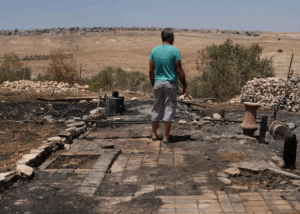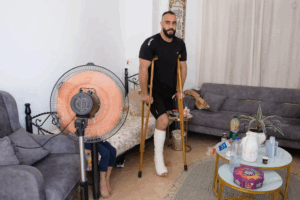Palestinians no longer live in this valley. They’re afraid to even approach it

Ali Askar among the charred ruins of his family’s farmhouse, July 2025
Gideon Levy reports in Haaretz on 26 July 2025:
Danger lurks everywhere.
It’s dangerous to take the flocks to pasture, dangerous to hike in nature, dangerous to work the land, dangerous even to try to access it.
Since the war broke out in the Gaza Strip – and in the West Bank Palestinian communities that have become the backyard of that war – the terrain there has undergone a radical metamorphosis. Compounding the hundreds of army checkpoints; the vicious economic crunch caused by Israel’s lockdowns of villages and towns; the brutality of soldiers that has reached new peaks; the army’s random, endless raids; the innumerable wild settler outposts established without interference from the authorities; and the almost-daily pogroms carried out by settlers – there is a feeling of abject terror.
It’s a terror of leaving your house and even more of venturing outside the community you live in. Everything is simply more dangerous on the outside. Violent settlers are lurking everywhere; there is no one to stop them. They observe things from afar and swiftly assault anyone who dares to walk about in open areas, most of which are privately owned by Palestinians, in the West Bank.
Since October 7, the territories have seen a proliferation of houses of mourning, for the hundreds of residents who have been killed by army and settler gunfire, as well as thousands of wounded people who are trying to recover from the brutality of settlers occurring under Israel Defense Forces auspices.
In the past few weeks we visited some of the wounded, each in a different part of the West Bank. In the town of Hizma, east of Jerusalem, three people are recovering after being attacked recently by settlers. One is Ouda Ahmed Askar, 29, an unmarried construction worker whose leg was recently shattered by bullets and is recuperating in his brother’s home.

Ouda Askar, who was shot in the leg by settlers, July 2025
The incident in question occurred on June 29, a Sunday. Sabrine, Ouda’s 25-year-old sister, took the family’s sheep out to pasture together with her 3-year-old niece, Ibtisam. The family keeps a flock of about 100 in a pen on the outskirts of town, on the edge of a great valley, in an area known as Biryat Hizma. It was afternoon. Sabrine hoped to lead the animals into the valley, although settlers sometimes lurk there under two carob trees at the center of the grassy expanse.
An instant later, eight masked settlers, four of them armed with rifles and pistols, descended from a nearby hill and positioned themselves opposite Sabrine and Ibtisam. They had apparently come from one of the outposts hidden on the other side of the ridge. As though sprouting out of nowhere, not far from the sheep’s pen, the settlement of Adam, aka Geva Binyamin, has spread over several hills, leaping from one to the next, with a number of small but violent outposts nestled in between.
Seeing the settlers, Sabrine immediately sent Ouda a WhatsApp message, urging him to come quickly. He arrived at the scene immediately, as did about 20 relatives and neighbors. Sabrine, who rushed with her niece out of the valley, later told her family that one of the settlers had threatened them in Arabic, saying that if they dared to return with the sheep the settlers would impound the flock and burn their pen.
“We will do to you what we did in Kafr Malik,” the settlers warned, referring to a pogrom that had been perpetrated on June 25, just four days earlier, in which three Palestinians were shot dead by the army, while a large number of cars and other property were torched by settlers.
In short order the area abutting the valley turned into a war zone. The townspeople hurled stones at the settlers to drive them away as the settlers threatened to advance toward their homes and animal pens, while throwing stones at the Palestinians.
Suddenly the settlers also started shooting. About 50 meters separated the two groups – the encroachers and the townspeople. There were bursts of gunfire from the settlers, Ouda relates. Bullets whistled over his head.
Suddenly Ouda realized that he had been hit in the right leg. He somehow managed to flee with the help of a friend who hustled him into his car, at which point the settlers also shot and wounded the friend as well. The two men managed to drive to the medical clinic in Hizma, where another wounded person had also arrived; he had been shot in the shoulder during the same attack. The three were then evacuated by ambulance to the Governmental Hospital in Ramallah.
Upon hearing the settlers’ gunshots, the Palestinians fled back to town in a panic. Neither the army nor the police were in evidence. The retreat of the townspeople enabled the settlers to do their second-most favorite thing – after live-fire shooting at Palestinians – namely, setting Palestinian property ablaze.
They set fire to the Askars’ farmhouse, which stood on the edge of the valley. It was a colorful wood structure, we saw in the photographs, where the family went when they wanted to enjoy a bit of peace and quiet on their land, in the lap of nature. It was adorned with decorative plantings and pots of flowers. Nothing remains of it now.
Ouda underwent two operations on his leg and was hospitalized for eight days. Next month, he will begin physiotherapy but in the meantime he’s bedridden. The friend who rescued him, and asked not to be identified by name, also spent a week in hospital.
Three other expanded families lived in proximity to this valley up until the war broke out in Gaza. One was compelled to leave after their homes were demolished by officials from the Civil Administration, a branch of the military government; the other two families, terrorized by settlers, moved 5 kilometers eastward.
The valley was “cleansed.”
Amer Aruri, a field researcher for the Israeli human rights organization B’Tselem, has documented six attacks by settlers that expedited the cleansing of Palestinian inhabitants in the valley. With the separation barrier severing the latter from 40 percent of their land for over two decades, there’s been a significant rise in encroachments and assaults by settlers in the vicinity of Hizma since October 7, according to B’Tselem.
The settlers don’t enter the densely populated town, at whose entrance the army has recently installed a yellow steel barrier (which was open this week). Rather, they make do with expelling anyone living nearby or entering the valley at the outskirts of Hizma – even its most remote edges.
Back to the incident with Ouda: An army unit arrived at the clinic to which he and his friend had driven, but they were already in the hospital by then. A Shin Bet security service interrogator called Ouda there, but he was in no condition to speak. Since then he says hasn’t heard anything from the Israeli authorities.
One local resident told Ouda that after he had fled, the army showed up and an officer had told this person: “The settlers are crazy. We can’t stop them. Don’t mess with them and don’t throw stones at them.”
We drove to the site of the incident with Ouda’s brother Ali, 40, a father of four, who also took part in protecting the family’s flock on that Sunday. He also showed us the ruins of houses nearby that the Civil Administration had demolished in recent years. Meanwhile, a new neighborhood of high-rises is being built not far away. The settlements of Anatot, in the east, and Adam, in the north, are perched on the ridges of the hills.
The two lone carob trees can be seen in the heart of the valley. The Askars’ olive grove there is divided into two sections. The family hasn’t been allowed to approach one of them since the war started; the other part has been uprooted by settlers. The rest of the valley is hilly, desolate, rocky. The family’s flock is in the pen; it can’t be taken to the valley for pasturing now.
Ouda’s father, a bearded, animated man named Mohammed, says he’s “around 70.” How many children do you have, we asked? Twenty. Yellow plastic containers, used for bringing water to the sheep, lie scattered nearby on the ground. A shepherd dog, chained up, bares its teeth and barks at us.
Not far away, all that’s left of the Askars’ farmhouse is dust and ashes.
This article is reproduced in its entirety
